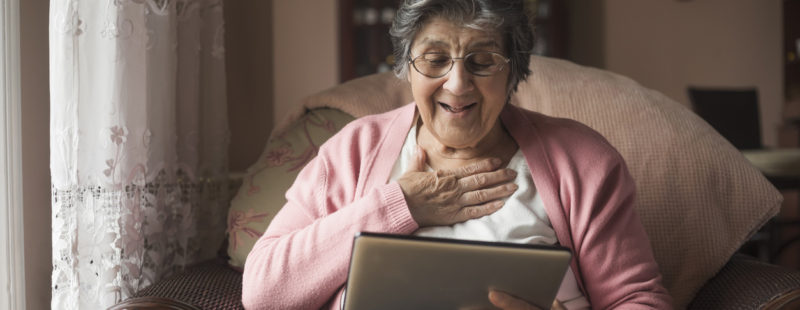One of the most striking things about lockdown has been the rapid escalation in the shift of work, services, activities and almost all aspects of daily life online. In this blog, we look at how charities and organisations can help tackle the digital divide.
Digital exclusion
Exploring the power of digital technology to reduce loneliness was a focus of the Government’s loneliness strategy, which gave rise to NESTA’s Tech to Connect Challenge at which I was a member of the judging panel. A key consideration around that Challenge was the need to involve user groups in design to help improve access for various groups including older people.
So thinking was underway, but the pandemic has forced us to accelerate plans for moving online ahead of action to address the digital divide.
While the idea that all older people aren’t online is a myth, there are still significant numbers of older people who are digitally excluded. In 2018, Age UK reported that 36% (4.2 million) of people age 65+ are offline, lapsed or have never used the internet.
But digital inclusion is not just about whether we are online. We know from the ONS that, before the pandemic, people over the age of 65 who were online, were still much less likely (48%) to do their shopping online compared to the national average (78%), look for health information (30% vs 54%) or access online banking (35% vs 69%).
And people who use the internet only shallowly or not at all are also more likely to have weaker networks in the real world. The Centre for Ageing Better and Good Things Foundation found that digital exclusion is closely related to social exclusion and inequality. In other words, the people we are most concerned about in relation to loneliness are also most likely to be digitally excluded (and vice versa).
There are three elements to digital exclusion: lack of kit; lack of skills and confidence in going online; and a lack of connectivity and /or data.
Of course, we need to be mindful of stereotypes – for some older people lockdown has been a catalyst for investing in a new tablet or dusting down a neglected laptop. And many older people, like Grandma Williams, were already digitally literate and are enjoying their time online.
New opportunities
Digital modes of connection have become more and more important for people who are online, with many organisations moving to digital services and innovating new approaches – peer support groups, online crafting communities, even online choirs. Similarly, many people have found online platforms such as Zoom and FaceTime vital for keeping in touch with grandchildren.
These new opportunities to connect have been a lifeline to those who have been shielding – to maintain and preserve existing relationships and community connections.
But for others, a lack of online connection has been a significant barrier – creating challenges in accessing services, from banking to shopping, and compounding the impact of lockdown on their social relationships.
For those whose network of support was already poor, the challenge, and the impact of loneliness is much starker. It is hard to build relationships that are meaningful and sustaining through digital means alone.
“The gap between digital haves and have nots has never been wider.”
We are seeing many organisations stepping into that gap. Businesses and the voluntary sector are providing devices and connection to people who are digitally excluded and providing support to people to get online. However, we know people who are newly online need lots of support – and there are limitations to how much we can realistically expect to achieve during a lockdown. The easing of lockdown is a window of opportunity to accelerate this work, as the ILC, among others, has called for.
Yet there are also limitations to the potential of digital connection. The research prior to Covid suggests that while digital tools for connection have potential, there is a way to go. And there is evidence on the importance of a wide range of forms of connection including casual contact with neighbours, and seeing one another face to face, which can’t necessarily be replicated online.
If periods of lockdown and social distancing are to be part of our lives for the long-term, we need to think more about the new challenges we’ll be facing



.png)


No comments on this article yet. Please feel free to submit a comment below.
By submitting a comment you grant Campaign to End Loneliness a perpetual license to reproduce your words and name/web site in attribution. Inappropriate and irrelevant comments will be removed at an admin's discretion. Your email is used for verification purposes only, it will never be shared.